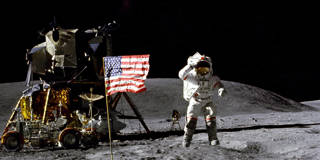OnPoint Subscriber Exclusive
Longer Reads provide in-depth analysis of the ideas and forces shaping politics, economics, international affairs, and more.

Are Moonshots Still Possible?
A half-century after the first Moon landing, America’s triumph in the Space Race still stands out as an unparalleled feat of perseverance and ingenuity. Had advances in human space travel continued apace, there would almost certainly be human footprints on Mars, too.
CAMBRIDGE – I cannot look at the Moon without being reminded of July 20, 1969, when Neil Armstrong and Buzz Aldrin planted the first human footprints on its dusty surface. Then a young astronomer at the University of Cambridge, where the English astronomer Fred Hoyle was the top professor, I joined hundreds of millions of others around the world in witnessing grainy television images of that historic moment. When I met Fred the next day, he was enthralled. In addition to being a brilliant scientist, he was also an author of science fiction and had been anticipating this moment since his own childhood in the 1920s.